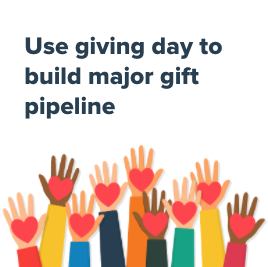Last week on Linkedin, James Barnard, Executive Director of Annual Giving and Integrated Marketing at the University of Cincinnati Foundation asked his fellow fundraisers a critical question: What metrics are you using to define the success of your giving day?
Historically, teams have measured success by the number of donors or gifts and left it at that. Maybe there’s a thank you email or letter after a gift is made, but not much else.
That’s a huge missed opportunity for stewardship, pipeline generation, and so much more. Use these three metrics to measure your success this year and learn to make the most of the momentum you’ll gain during giving day.
High net worth donor engagement
How many donors from this year’s giving day are high net worth individuals? How many are assigned prospects?
Giving day isn’t just about donor participation. Tracking donors’ net worth and providing personalized stewardship experiences to high net worth donors will help you build relationships with wealthy donors. Not only that, you’ll also grow your future major gift pipeline for months and years to come.
It’s simple. The more high net worth donors that you’re able to engage, the more high net worth donors you’ll have assigned to gift officers and in conversations for future gifts.
Take Northern Illinois University for example, who used net worth data in EverTrue to help identify over 500 pre-qualified major gift suspects after their giving day in late-2020. The next step was assigning them and following up, because giving day really is just the beginning.
Bonus points if you’re like NIU and are tracking the funds to which donors are giving to better understand donors’ philanthropic priorities. Donors are raising their hands, telling you what they’re passionate about, both with social media engagement or donations to specific funds. Track these interests to use for segmentation down the line (if you’re an EverTrue customer, just create a list for each interest and use that for follow-up).

Giving day is an incredible prospect discovery tool, and institutions that use this to their advantage will have better relationships with more donors than those who simply send a “thank you” email and forget about most donors until next year.
Tracking major gift pipeline
So you’ve qualified and engaged with your high net worth giving day donors.
Now it’s time to follow up. Make some calls, book some virtual coffees, send personal “thank you’s.” Whatever you like. What matters most is building relationships (or nurturing existing relationships) with high capacity donors that raised their hands during giving day. Get to know them.
What are their philanthropic interests? Should they be in a gift officer portfolio? Following up with high net worth constituents that engaged during giving day but did not make a gift is equally as important. Use their interest information to follow up and start a conversation.
Continue nurturing those relationships and growing major gift pipeline days, weeks, and months after giving day. How many assignments and solicitations came out of giving day outreach and follow up? This is both an incredible relationship building activity, and a chance to measure the true impact of your time and resource investment.
Tracking major gift revenue
Speaking of measuring impact, it goes without saying that you should be measuring major gift revenue resulting from giving day and the resulting follow-up activities. How much major gift revenue can be traced back to giving day six months or a year after the day itself?
According to Brent, “The end of giving day should be the beginning of a new wave of major gift relationships and revenue.”
The bottom line
As James so wisely states, “If your day of giving reporting ends a week after the event, you’re doing it wrong.”
Need more guidance? Use Brent’s comment as a template for reporting on giving day to university leadership:
“This year our day of giving raised XXX from XXX donors. This represents X% of our annual giving donors and Y% of our annual giving dollars.
XXX of donors were highly rated prospects that were previously unassigned.
XXX of these donors were added to special stewardship portfolios.
XXX of these donors are now in discussion for larger gifts with $XXX million of pipeline.
Additionally, we engaged XXX number of alumni via Facebook who did not give. Through continued follow-up and personalized outreach, we were able to convert XXX of these engaged, non-giving day donors, securing XXX more gifts and $XXX in revenue.”
Use this handy giving day assessment form to visualize the most important metrics. You can also download the document here.
| Giving Day Assessment Form | ||
| Metric | Total | Comments |
| # of donors | ||
| # of dollars raised | ||
| # of Facebook engagers | How many people engaged on Giving Day-themed posts leading up to and during your Day of Giving? | |
| # of Facebook engagers who gave | Be sure to continue nurturing people who engaged, but didn’t give, with impact stories. Look at this list again in 3 months. Who has made a gift since giving day? How much additional revenue did you gain? | |
| # of assigned prospects who gave | Ensure gift officers follow up and thank them quickly. | |
| # of unassigned, high net worth prospects who gave | What is the stewardship plan? Gift officers should reach out and book virtual qualification visits. | |
| # of new assignments made | Look at the above list in 3 months. Who is now assigned to a gift officer? | |
| $ of pipeline created | In 6 months and again in 12, look at how much major gift pipeline was the direct result of your Giving Day (i.e. new assignments with an open proposal or targeted ask amount). | |
See how the University of Miami used Facebook to identify 7,000 new major gift prospects and closed more than $600,000 in new gifts this year.
